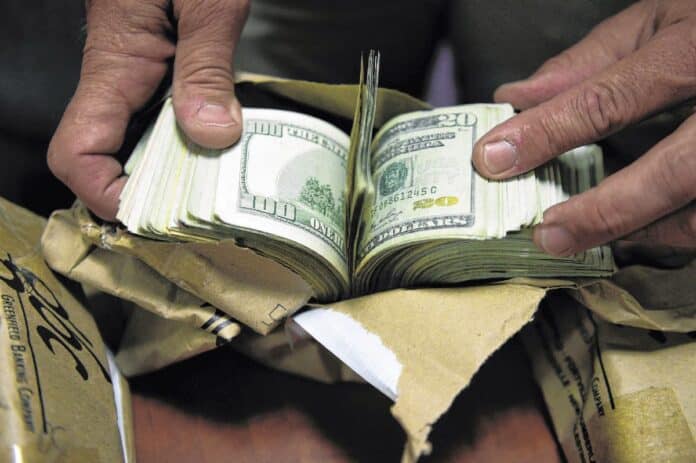
HANCOCK COUNTY — They call it "dirty money."
It is cash and other assets taken from people who have been targeted in criminal investigations. Law enforcement agencies, which are allowed to keep the valuables, use them as a revenue stream to supplement their budgets.
A prime example is the $43,000 in cash that Hancock County Sheriff Brad Burkhart has kept in a safe at the Hancock County Sheriff’s Department. It was money his deputies seized from an illegal operation. A percentage of the cash will one day be used for equipment and other needs that arise.
All law enforcement agencies have asset forfeiture accounts, and they can be a lucrative source of funds. But the idea of asset forfeiture is controversial. Courts have faced many challenges over the practice, and the Indiana Supreme Court earlier this year was reversed by the U.S. Supreme Court in a ruling in a forfeiture case. In that challenge, the Indiana court had ruled that police had lawfully seized a $42,000 Land Rover from a man who had been convicted of possessing a small amount of heroin. He presented evidence that showed the vehicle had been purchased with proceeds from a life insurance policy, not drug money.
[sc:text-divider text-divider-title=”Story continues below gallery” ]Click here to purchase photos from this gallery
The U.S. Supreme Court ruled that forfeiture violated the Eighth Amendment’s prohibition on excessive fines.
But while the courts haggle over the practice, it continues.
Just recently, officials from the Greenfield Police Department were in Hancock County Circuit Court trying to secure nearly $1,500 they’d taken from an individual during a drug bust. Commissioner Cody Coombs ruled in favor of GPD to keep the money after the defendant didn’t show up to object.
Courts act as arbiters and make sure the money is divided properly. Law enforcement, lawyers in the case and the state’s common school fund receive shares.
Officials can then use their portion of the money for any purpose, GPD deputy chief Matt Holland said, such as investigative equipment or training.
"As long as we believe or have proof the money or material, like a vehicle, is a proceed of some kind of illegal activity, we can seize it," Holland said. "But there has to be probable cause, and there is a burden of proof."
A bill went into effect last summer that helps dictate how proceeds from seizures should be distributed between law enforcement agencies and the state. A closer look at local forfeiture funds shows how the funds have accrued.
The four different types of forfeiture funds for the sheriff’s department in 2019 include the Law Enforcement Forfeiture/Seizure fund: $35,204, PACE State Asset Seizure fund; $9,749, Department of Treasury Equitable share: $23,739 and the Sheriff Equitable share: $34,721.
Federal laws forbid the county to use any seized funds to supplant a county budget, so any forfeiture, literally, is bonus money.
Sheriff’s officials used seized money to purchase a police car this year. In 2012, when they needed a structure at the county shooting range, half of the money came from seizure funds, with the rest coming from commissary funds.
"The $100,000 to build that training facility was non-taxpayer money," Burkhart said.
County Auditor Debra Carnes monitors all the funds coming in and out of the county, including at the prosecutor’s office and the sheriff’s department. From Jan. 1, 2016, until this week, she said, the county has had only three court cases that have dictated what they needed to do with seized funds.
Her office will only hear about a county case when a court order is issued telling them who gets the money from a forfeiture.
A look at the GPD forfeiture fund over the past three years indicates the department has not had many forfeitures.
Clerk-Treasurer Lori Elmore said records show the GPD started 2017 with $5,140 in the forfeiture fund. It had a balance of $15,865 heading into 2018. In 2019, after a number of purchases, the department began the year with $1,493 and now has a balance of $4,665. The current balance doesn’t include the money GPD was awarded in the recent court decision.
The money in forfeiture accounts cannot be used for salaries, Elmore said. She files a report each year complete with receipts showing what officials use the money for. That has included ammunition, K-9 equipment, a K-9 first-aid kit, cartridges, a WiFi-camera, new equipment for an interview room and a new desk in the detectives’ office.
GPD also has a state seizure fund and a homeland security seizure fund as a result of one of their officers being assigned to a Department of Homeland Security task force.
Holland acknowledged the discussions that are taking place about forfeitures and what can be forfeited as a result of criminal investigations. He knows more changes might be on the way. For now, the law is clear, and law enforcement can and will use forfeiture laws whenever they see fit.
"If somebody is making proceeds through illegal activity like selling drugs, we can seize that and use it to fight drugs," Holland said.
[sc:pullout-title pullout-title=”By the numbers” ][sc:pullout-text-begin]
FORFEITURE FUNDS 2019 HANCOCK COUNTY SHERIFF’S DEPARTMENT:
Law Enforcement Forfeiture/Seizure: $35,204
Pace State Asset Seizure Fund: $9,749
Department of Treasury Equitable Share: $23,739
Sheriff Equitable Share: $34,721
FORFEITURE FUND GREENFIELD POLICE DEPARTMENT:
2017 year end total: $15,866
2018 year end total: $1,493
2019 to date total: $4,665
[sc:pullout-text-end]




